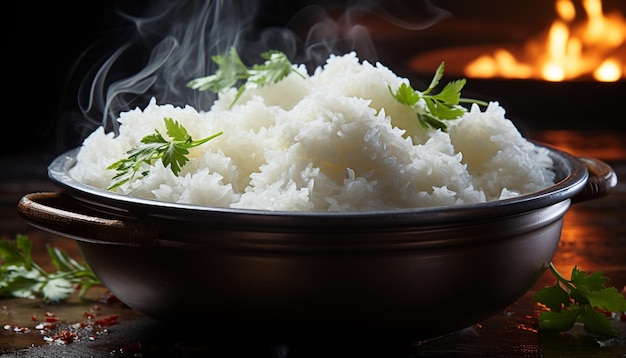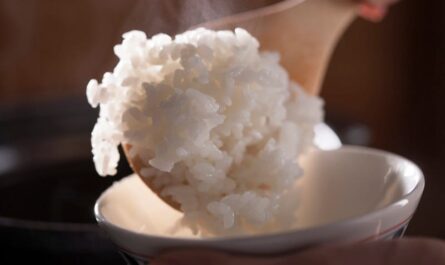Sushi lovers understand the importance of getting rice just right. The art of making perfectly soft and sticky rice can make or break your sushi experience. And when it comes to making sushi at home, using pressure cooked short grain rice can be a game changer. In this article, we’ll delve into how pressure cooking can enhance your sushi rice and why it’s preferred by sushi aficionados.
The magic of pressure cooking lies in its ability to reduce cooking time while bringing out a delightful texture. By pressure-cooking short grain rice, sushi lovers can achieve that perfect balance of softness and slight clumpiness necessary for holding sushi together. So, what makes this method so popular, and how can you take advantage of it at home?

Why Choose Pressure-Cooked Sushi Rice?
Sushi rice requires a specific consistency to ensure that sushi holds its shape without losing its unique flavor. Traditional methods can be time-consuming, often risking over or undercooking that can ruin the texture. Using a pressure cooker simplifies this process and ensures consistent results every time.
Achieving Perfection with Short Grain Rice
Short grain rice is a staple in Asian cuisine, particularly in sushi. The grains stick together better than long grain varieties, making them ideal for sushi rolls and nigiri. Learn more about the characteristics of short grain rice as it aids in crafting savory sushi meals.
The Science Behind Pressure Cooking
Pressure cooking uses steam pressure to cook food much faster than conventional methods. For sushi chefs and enthusiasts, this means less waiting time and a reduced risk of cooking errors. The sealed environment also helps to preserve the flavors and nutrients of the rice, making it a healthier choice.
Step-by-Step Guide to Cooking Sushi Rice in a Pressure Cooker
This guide is easy to follow and will have you preparing the ideal rice for sushi in no time:
1. Gather Your Ingredients
You’ll need 1 cup of short grain rice, 1 1/4 cups of water, a pinch of salt, rice vinegar, sugar, and salt for seasoning. Make sure all your ingredients are fresh for the best results. See compact sushi kits that might help you in your sushi journey.
2. Rinse the Rice
Rinsing is crucial. It removes excess starch that can make the rice overly sticky. Rinse the rice in cold water until the water is clear.
3. Set Up Your Pressure Cooker
Add the rinsed rice and water to the pressure cooker. Secure the lid and set the pressure to high, cooking for 5 minutes.
4. Let It Rest
Once the cooking cycle is complete, allow the pressure to naturally release for about 10 minutes before opening the lid.
5. Season Your Rice
Mix rice vinegar, sugar, and salt. Gently fold into the rice until well combined. Your pressure cooked short grain rice is now ready to use in various sushi recipes.
Finding the Right Balance of Flavors
The balance of flavors in sushi rice is essential for authentic results. By cooking with precision, flavors blend better, enhancing the overall sushi taste.
Quality Matters
Hunt for high-quality rice, as the freshness and type will strongly impact the final dish.
Sushi and Presentation
Creating visually appealing sushi to share with friends is half the fun. Practice makes perfect, and selecting the right rice is key to stunning sushi plates.
The Relevance of Short Grain Rice to Sushi
Given its unique characteristics, short grain rice stands out for sushi making. It has distinct sticky properties that are a must for this Japanese delicacy.
Matching Rice Types with Sushi Varieties
Different types of sushi may warrant different textures of rice. Understanding these nuanced differences can make a notable difference.
Benefits of Cooking Sushi Rice at Home
Making your own sushi allows for customization and provides a fulfilling culinary experience. It also ensures that you can control seasoning, quality, and portion size according to your preference.
Embrace Creativity
Don’t hesitate to explore different ingredients or presentations. Home preparation allows you to try exciting variations without limits, sparking creativity.
Serving and Storing Sushi Right
Properly storing leftover sushi rice is a must to maintain its taste. Use airtight containers to keep leftover rice fresh for the next day’s meal.
Maintaining Sushi Tools
Keep sushi tools fresh and well-maintained to prolong their lifespan and ensure cleanliness.
Common Mistakes to Avoid
The most common errors include not rinsing rice thoroughly, overcooking, and improper rice to water ratio. Avoid these mistakes for the best outcomes.
Sustainability in Sushi Rice Production
Sustainable rice farming is crucial for environmental health. Opt for sustainably grown rice to contribute positively to our planet.
Understanding Rice Farming
Be aware of the impact and benefits that come with supporting sustainable practices. Such considerations have long-term perks beyond the kitchen.

FAQ Section
Q1: Why is short grain rice preferred for sushi?
Short grain rice is preferred for its sticky, clumping nature that holds sushi together perfectly.
Q2: How can I best season my sushi rice?
By blending rice vinegar, sugar, and salt according to taste, you can season your sushi rice effectively.
Q3: Can I use a regular pot instead of a pressure cooker?
Yes, but a pressure cooker offers precision and consistency, enhancing the overall texture and flavor of your sushi rice.
This article contains affiliate links. We may earn a commission at no extra cost to you.



